Chapter Twenty-Nine
Spirit of the Guru
When hundreds of thousands of Sri Lankans were driven from their homeland by civil war in the 1980s and 90s, Gurudeva reached out to assist and guide their lives in new nations. As they had fallen at Yogaswami’s feet during earlier ethnic crises, Sri Lankan Tamils shared their woes with Gurudeva. It was a difficult work, listening to thousands of tragic stories, answering again and again the question “How could God allow such things to happen?” §
Throughout it all, Gurudeva never avoided a call, never failed to give all the time necessary to a family in need, whether they had lost their son, watched their home being burned to the ground or been compelled to flee their homeland and begin a new life in a strange place. Their calls to Gurudeva were a lifeline, and he knew it. The calls, continuing for two decades, came from India, Canada, America, Germany, Denmark, Sweden, Norway, Finland, Africa, Australia, New Zealand, England and France. The massive racial riots and ensuing civil war between the Tamil Hindus and the Sinhalese Buddhists in Sri Lanka ultimately caused an exodus of 700,000 Tamils. §
By divine grace Gurudeva had traveled throughout the Hindu areas of Sri Lanka in 1983, only months before the killings began. In fact, he was in Anuradhapura when a bomb went off at Elephant Pass, the narrow causeway between the Jaffna peninsula and the Sri Lankan mainland. He and the monks were supposed to leave for Jaffna that morning, but Gurudeva kept delaying the departure. They finally left about noon, arriving at the bomb site later in the day to encounter intense scrutiny by the Sinhalese army. Had they left on time, they may have been in the area when the blast occurred. And, if the bomb had actually hit its target (no one was hurt by it), the riots which occurred a few months later could have started then and there. His message, given in dozens of temples, would fortify Sri Lanka’s Hindus in the trying times ahead: “Stand strong for Hinduism!” “Fear neither death nor those who live in fear.” §
In 1985, following some particularly horrific happenings in and around Jaffna, Gurudeva gathered his monks together to create the Sri Lanka Refugee Relief Fund, raising critical financial support from Tamils in the West to help the homeless victims of war. He spent months on this project. As funds began flooding in, he watched as each transfer was made, to assure it would actually go to the needy. His initiative inspired others to collect donations and send financial aid to the island nation. §
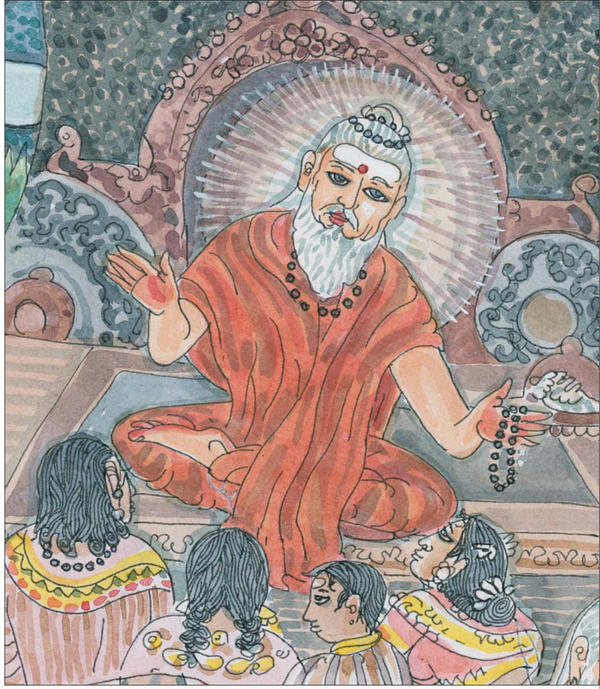
Almost daily at Kauai Aadheenam, visitors would meet Gurudeva in the Guru Pitham, sharing their life’s purpose and problems, receiving spiritual counsel and leaving with a book and life-affirming blessing.
• • • • • • • • • • • • • • • • • • • • • • • •§
Soon after the conflict started, Gurudeva closed his ashram and school in Alaveddy. A decade and a half later he remarked:§
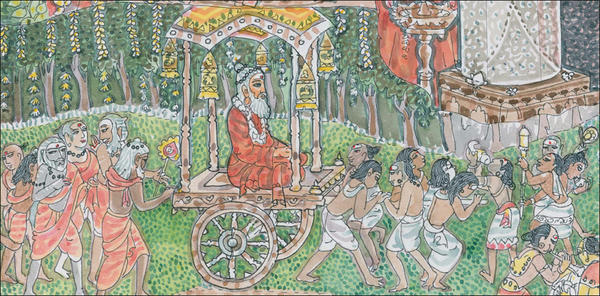
Each year during the July festival of Guru Purnima the monks and devotees paraded Gurudeva in a chariot down the San Marga path to the Svayambhu Sivalingam where pada puja was performed.
• • • • • • • • • • • • • • • • • • • • • • • •§
Learning of the imminent conflict by listening to the elders, we closed all our activities in Sri Lanka and centered our work outside of the United States in the country of Mauritius. Then we found out from the elders that the place Sri Lankans were wanting to reincarnate was Mauritius. So, the Sri Lankans are reincarnating in Mauritius. They are probably fifteen to eighteen years of age now. I sent two swamis to Mauritius to conduct youth camps. Our missionaries there are family men and women, and every member of the organization is connected to a missionary family. Everybody watches after everyone else. §
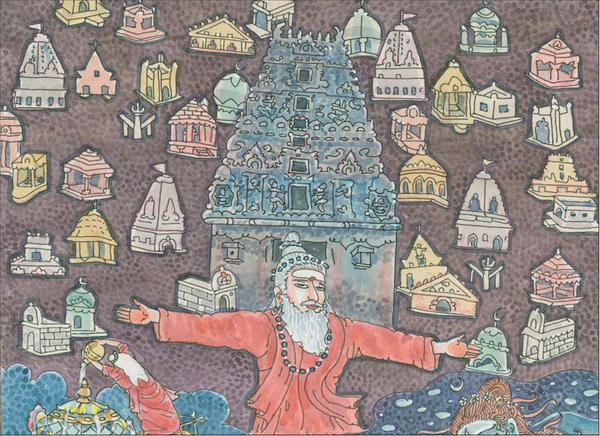
On every continent, Gurudeva worked with communities to build Hindu temples, to guide their trustees, even to raise funds for them. In all, he helped build 37 temples during his life.
• • • • • • • • • • • • • • • • • • • • • • • •§
The Tamils who began settling in the West appreciated Gurudeva’s commanding presence, traditional ways and clear guidance. Rather than lamenting their losses, he showed them their opportunities, enjoining them to settle down and become contributing members of their new countries. His simple words to many were, “Unpack your bags.” Most had not committed to their new country and were living as if waiting to catch a flight home to Sri Lanka. He gave insights into integration, citizenship, public relations and more, urging each group to start a temple, saying that the culture and religion comes from the worship and they need temples close by to preserve their heritage and pass it on to their children. He unstintingly gave them his personal cell phone number, knowing that calls would come anytime, day or night. §
In 1995, with two monks at his side, Gurudeva undertook a 21-day European tour, covering Germany, Denmark, Switzerland, Austria and the UK. He visited all of the Tamil Hindu communities in those countries, had a street parade of 11,000 in Hamm, brought converts into Hinduism, revisited Ascona, where Shum came through in 1968, and uplifted the thousands of Tamil refugees in these nations.§
Everywhere he encouraged them to pray for peace by chanting “Aum” and sending energy to loved ones still in Sri Lanka. He repeated the message he had given since 1983 and taught them ways to endear themselves to the local community:§
Your karmas brought you to this country, and you have more opportunities here than if you went to the University of Colombo. Educate your children, learn the local language and settle down. When permanent peace comes to Sri Lanka, then you can go back.§
I think we all appreciate what the governments have done. There are many ways we can pay back. One way is to smile at everybody you meet. You smile, and then they smile, and pretty soon the whole country is smiling, just because you smiled. To be happy yourself, you have to make someone else happy.§
Mrs. Puvanesam Veeragathiyar shared:§
He visited a boys’ refugee house in Berlin, talked with the officials and saw to the boys’ material needs. He then met with a group of mothers and told us that what was lacking in these boys’ lives was a mother’s love. He encouraged us to invite the boys and other refugees to our home for meals and make them feel part of our family. Most of us are still doing this today.§
Many tell of the special magic held by Gurudeva’s business cards and photos, which he gave out by the hundreds of thousands during his travels. Some reported easily passing through Sri Lankan military checkpoints after showing Gurudeva’s picture. M. Elangovan of Italy related: §
In 1990, when I was 14, I left Sri Lanka in a fishing boat to India. The only picture I had in my wallet was Gurudeva’s. That picture helped me through difficult times. Even today I have the same picture in my wallet. Gurudeva has always been with me, helping and guiding me.§
Gurudeva showed up for the Tamil people of Sri Lanka in even deeper mystical ways, including simply being there for them on the astral plane as many passed away during the hostilities. When his monastics at his Kauai monastery noticed him taking naps during the morning hours, they asked him if he was feeling alright. He assured them that he was fine; he was spending this seemingly idle time quite actively in the inner worlds, blessing souls who had recently died in Sri Lanka, placing the mark of vibhuti on their foreheads as they came to him in long lines. He would visit his shishyas in far-off places on the astral plane, working with their lives and karmas, providing solace, guidance, protection.§
Thiru Satkunendran of Toronto, Canada, recalled:§
Gurudeva was not only our spiritual guide, but also a highly respected mentor, for both the young and old suffering from culture shock. Every occasion that I met Gurudeva, he was keen to know of progress made towards peace in Sri Lanka. He was always prepared to offer his services as mediator. Such is the love of this great guru towards the island and people, where he found his satguru, Yogaswami. We are certain that he is working for peace even now, from the inner world.§
Gurudeva explained some of the challenges of that time: §
During that time, we were getting the Sri Lankan devotees settled down as best we could. It was very difficult, because everyone was migrating here and there and everywhere. In Germany we had what were called “container boys.” They would get smuggled into Russia, and in Russia they would get put in containers and be smuggled into Germany. Many died of suffocation. But most arrived in pretty good shape. We encouraged Tamil families to take them in. The German government was extremely compassionate and kind. §

At temples in Sri Lanka, Fiji, Texas and elsewhere, Gurudeva poured the sacred kumbha over the tower during the kumbhabhishekam ceremony.
• • • • • • • • • • • • • • • • • • • • • • • •§
“Build Those Temples!”
Throughout his adult life, Gurudeva recognized the need for the Hindu temple as the center of religion and culture. He was involved in the planning, building or consecration of 37 temples on several continents. He knew that for Hindus to truly feel at home anywhere on the globe, they needed temples nearby, temples that gave devotees access to their God and the Gods. And he assured one and all that the Gods are actual inner-plane beings rather than just symbols as is sometimes claimed. From his own experience, he colorfully described the beings who live in the heavenly realms, what they do and how they can be of practical assistance to devotees requesting their aid.§
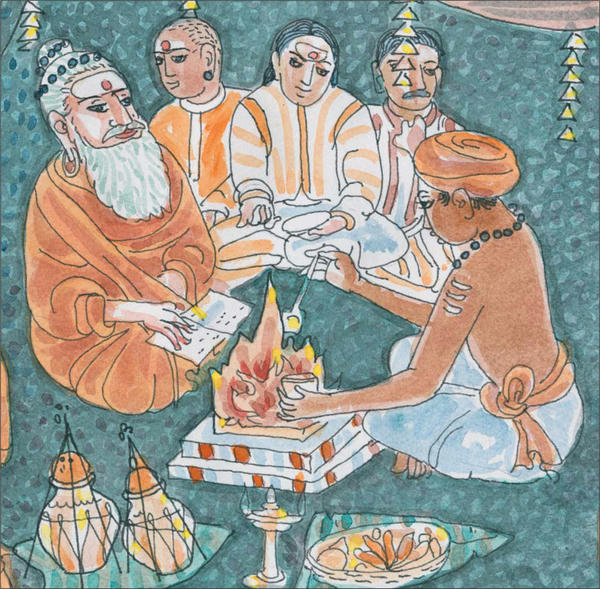
The weekly homa in Kadavul Hindu Temple became a central rite for the monastery and devotees. Afterwards he would give a discourse, answer questions from CyberCadets and bless all who attended.
• • • • • • • • • • • • • • • • • • • • • • • •§
My devotees wisely settle in areas where Ganesha, Murugan or Siva temples exist for their frequent pilgrimage, worship and spiritual security. None should live farther than a day’s journey from such sacred sanctuaries. It is in the Hindu temple that the three worlds meet and devotees invoke the Gods of our religion. The temple is built as a palace in which the Gods reside. It is the visible home of the Gods, a sacred place unlike every other place on the Earth. The Hindu must associate himself with these Gods in a very sensitive way when he approaches the temple.§
You can go to a Hindu temple with your mind filled up with worries, you can be in a state of jealousy and anger, and leave the temple wondering what you were disturbed about, completely free from the mental burdens and feeling secure. So great are the divine psychiatrists, the Gods of our religion, who live in the Third World, who come from the Third World to this world where our priests perform the pujas and invoke their presence over the stone image.§
In this he was unique, as most swamis were not enthusiastic about temples, preferring to focus on social upliftment, philosophical teachings and yoga. Gurudeva described his approach:§
In the 1980s, Hindu Indian community elders of newly forming temple and cultural societies approached me to help them make the final leap in establishing temples in various states of our country. We accomplished this by gifting them large murtis, always of Lord Ganesha, to begin the worship. These were times of fostering and inspiring temple groups throughout North America. In case after case, within two years, million-dollar facilities to house the other Deities were built as funding began to flow in the wake of satisfaction experienced by dadis and dadas, appas and ammas and their coming-up generation. This brought us into a new area of seva, service, to the Hindu public.§
At the same time, we were encouraging getting temples started in Europe. We visited one small group that was conducting pujas in a basement. I gave fifty dollars, saying, “We’re going to start a temple.” Six months later they had rented a large warehouse and built a temple inside it—a really nice temple, with a priest from Sri Lanka doing the pujas. I was invited back and was paraded around the temple with ten thousand people participating. The police had blocked off the entire area. It was quite a scene.§
Arumugan Saravanapavan, one of the founders of the multi-million-dollar Murugan Temple of North America in Maryland, a few miles from America’s Capitol, recalls his experience of Gurudeva’s temple-building thrust:§
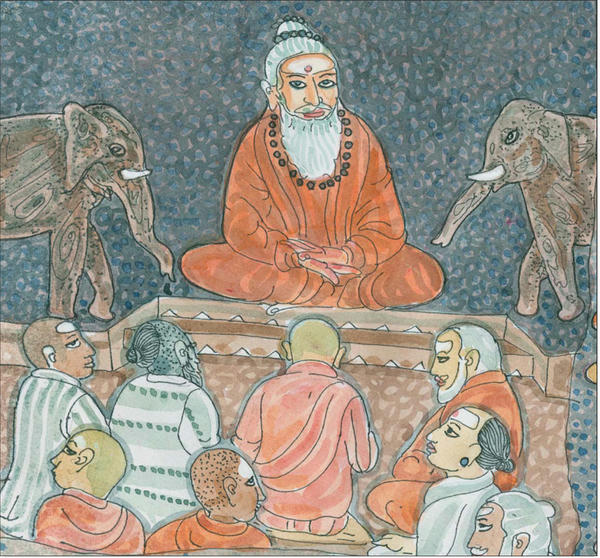
Each day Gurudeva shared lunch with all the monks, his seat flanked by two teak elephants. The monks sat below, on the brick floor, eating with their hands in traditional style and sharing news with their guru and brothers.
• • • • • • • • • • • • • • • • • • • • • • • •§
We wanted to build a temple in our area. Since we didn’t have land, or a clear idea of how to proceed, someone suggested we see Subramuniyaswami in Hawaii. The next week my wife and I went to visit him, in 1982. I explained the problem, and the next day he presented us with a three-foot-tall Ganesha. He said, “You take Pillaiyar with you, and He will show you the way to build the temple.” §
As instructed, they began the worship of Lord Ganesha, first in homes. The community’s devotion came to the fore. Gurudeva visited several times, helped with the planning and personally blessed the land they purchased. When Gurudeva spoke at that blessing, recalls Mrs. Guruswamy, wife of the temple’s first president, “The children were carried away. He was able to explain our religion in a way they could understand.” In 1999 Gurudeva was the honored guest at the temple’s mahakumbhabhishekam. A newsletter from the temple expressed gratitude: §
With his monks, Gurudeva helped every step of the way in building the Murugan Temple, from the community to the structure. As busy as he was, he made time to take phone calls from the temple devotees. He inspired the young and grew himself in many of our hearts. §
In 1982 he visited Chicago and met with a group interested in starting a temple. Previously, one of the trustees, Dr. N. Janakiraman, had visited Kauai. They were having a great number of problems, Janakiraman explained, and couldn’t agree on what to do next. They did, however, agree to do whatever Gurudeva told them to do. Gurudeva told them to start the worship of Lord Ganesha. “After receiving Gurudeva’s blessings,” said Janakiraman, “we returned home and, to our utmost surprise and ecstatic joy, Lord Ganesha had already arrived at the O’Hare airport.” Gurudeva had expedited the delivery as a surprise gift. §
A handful of devotees greeted the 2,000-pound statue and decided to start the worship in Mr. Rajagopalan’s home. The house soon proved too small to accommodate the crowds, so they moved Ganesha to an industrial complex in 1983. Gurudeva assigned one of his local devotees, Dr. Devananda Tandavan, to work with the community and keep him in touch with the progress. Thus was born the Hindu Temple of Greater Chicago.§
Gurudeva was a great fund-raiser for temples. He attended a few fund-raising meetings as the guest of honor in Chicago and gave an inspiring discourse each time, telling those gathered to get out their check books and write down a number—then “add a few more zeros.”§
When he visited one temple being renovated in Singapore, the trustees explained their fund-raising strategy to sponsor each square foot of the new temple for $100. Immediately he reached in his bag, took out a $100 bill and bought one sponsorship. It was likely, judging from the trustees’ astonished look, that he was the first visiting swami to ever contribute to their temple fund. Then he appealed for funds to the temple congregation during his speech. “I gave $100,” he said, “because I need the good karma of that gift to come back to me one day, maybe in the form of $500.” §

Dikshas marked key milestones in the monastic fellowship. From his traditional lion seat Gurudeva would offer blessings, sandalwood paste, vibhuti and home-grown rudraksha malas.
• • • • • • • • • • • • • • • • • • • • • • • •§
The same promotion was repeated to bolster temple fund-raising around the world. People were impressed to see him raise money like this for others, without saying a word about his own fund-raising needs. He told his monks often that by strengthening others, they would become strong; by helping others build their temples, his temple would manifest. In the years that followed, many he helped in their time of need turned their generosity toward him.§
In a similar way, Gurudeva was directly involved in three dozen other temples in the United States, Canada, Guadeloupe, Denmark, England, Fiji, Germany, Mauritius, New Zealand, Reunion, Russia, Sweden and Sri Lanka, giving each community or temple a granite murti and guidance when needed. He helped many more with direct advice, often dealing with fund-raising, zoning, community relationship building, priestly staff, debt management and more. §
The Maha Ganapathy Temple in Edmonton, Canada, is one of many that he guided closely. In addition, he helped this temple’s first priest immigrate from Sri Lanka. This was Subramanya Gurukkal, who had known Yogaswami as a young boy. Aran Veylan, an attorney in that community, recalls: §
The conception of the Edmonton temple came right from Gurudeva. It gives the temple a special power to be connected to Gurudeva in that way. He brought the whole community together. He defined the community as “Tamil Hindus,” because in the early 70s, the Tamils were a Tamil cultural group—Christians and Hindus together. Now the community has matured into a Tamil Saivite community, and that is all because of Gurudeva’s influence. §
The community went so far as to make the constitution of the temple state that one has to be a Saivite Hindu to be a member. Because of this, according to D. Selvarajah, one of the founding members, the temple now has a very clear and strong power. People from all over Canada come to this temple and have told Selvarajah it is the best temple in Canada and an example for them to follow. He recalls:§
Gurudeva told us in the beginning, “You have all built temples in Sri Lanka. Now, because of the children, you have to teach them what you know. The temple is what will bring the families together and the children together.”§
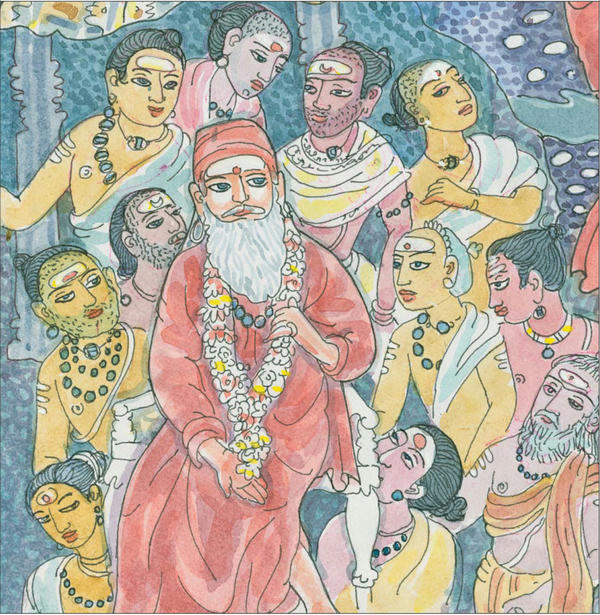
In 1995 Gurudeva met with 89 Adisaiva priests in Mumbai to discuss their future and offer his support. Throughout his life he gave prominence to the priests and taught others of their importance in the community.§
In Denmark, Gurudeva helped establish the Abirami Amman temple. The priestess, Sri Abirami Upasagi, is deeply psychic. While in trance, she channels the Goddess to heal and bless people. In the beginning she was criticized. In 1995 she had appealed to Gurudeva, as she felt these channelings were good and caused no harm. He assured her that what she was doing was correct and, giving her a Ganesha Deity, put her under his psychic protection. The icon arrived on the Ganesha Chaturthi festival day in August. They commenced the worship that same day, and milk began dripping from Ganesha’s eyes. §
A month later the famous “Milk Miracle” happened around the world, and this tiny statue began drinking gallons and gallons of milk offered before it with a small spoon. For many days after, hundreds of Hindus and local Danes came to feed Ganesha, including national television reporters. No one could explain the phenomenon witnessed by so many.§
A few months later, Gurudeva sent a three-foot-tall Goddess Amman Deity to that temple. With Gurudeva’s support, the priestess became a respected spiritual leader. In August of 2001, after leading a travel-study program through Northern Europe, Gurudeva laid the five traditional bricks to begin her new temple with his own hands.§
Now that hundreds of temples have been built all over the world, many trustees have asked, “What’s next?” Gurudeva gave the answer:§
I want to see the stewardship of each temple take their leadership responsibilities seriously. The temples are built, the temples are dedicated, the Deities are there, the priests are there, the congregation is there. It is up to the core elected leadership, the trustees of the temple, to actually become full-time spiritual leaders and make a difference in the lives of the parents and children and change the community into a model community.§
“Stop Bashing the Priests!”
Gurudeva stood ready to defend the priesthood who serve in the Hindu temples around the world. Especially in the early 90s he campaigned for fair treatment of temple priests. Not surprisingly, the priests, who had few champions for their cause, adored Gurudeva, invited him always to their temples and called upon him from time to time. §
The leader of the Adisaiva priest community, Sivasri Dr. T. S. Sambamurti Sivachariyar, wrote, “His support for us was great. At a time when many organizations and even governments were discouraging us, he always raised his voice on behalf of us around the world at difficult times.” In one of his HINDUISM TODAY Publisher’s Desk columns, Gurudeva wrote:§
Hindu priests, known as pujaris, are being bashed—physically, emotionally and mentally—by temple managers, trustees and sometimes even the devotees. We know that this is not right. Still, no one, well maybe a few, is objecting, except the priests themselves. Their objections and efforts to provide for their own security go largely unheard, as they are looked at by management as uneducated, simple people who perform rote rituals.§
Priest bashing is a popular sport outside of India. Priests have their sanga and elders back home in India to stand up for them. When a priest goes into disfavor, the slightest excuses are used to hurt him, such as wrongdoing in handling money—that is a favorite and usually the first to be used. The list goes on, giving management the permission to yell at him, push him, ignore his needs, embarrass him in front of his peers and sometimes the public.§
Yes, Hindu temple priest bashing is a worldwide tragedy, and those who perpetrate these acts are also bashing the Sanatana Dharma. Abusing priests is not to be taken lightly. Those who can invoke blessings from the Gods can also invoke curses from asuric forces of this planet for their own protection when angered, embarrassed and deeply hurt. This very thing happened in Hawaii when the Christians were converting all the followers of the powerful native kahuna priesthood. Some angered and became some of the best black magicians, feared to this day. They now live in the pretaloka, the astral plane close to Earth, afflicting wrongdoers and helping the faithful. It did not have to happen this way, but it did.§
Hindu temple priests deserve the richness of their holy profession, the dignity of their office, and this should not be interfered with. They have earned the same respect that any professional in “the real world” enjoys. §
The time has now come for Hindus to change our attitudes about temple priests. This will require temple managers to adjust their thinking. It will also require the international priesthood of the Sanatana Dharma to take a firm stand against their molesters and refuse to submit themselves day in and day out to harassment or to the humiliation of janitorial work and the handling of shoes. Some work fourteen hours a day and more. They are considered servants of the manager rather than the temple Gods. Their final justice may not be found in man’s law. It may be more mystical. They may decide to go to God’s unfailing law or, if so inclined, to the darker realms for relief. §
Beware! Their mantras are powerful. History shows entire societies that have gone down with their priesthoods. Let’s not have this happen again.§
While supporting legitimate priests, he criticized those who claimed social superiority by virtue of merely being born into the priestly caste: §
I don’t understand how some people claim they are brahmins because their fathers are brahmins. They don’t know the religion, and they can’t do the worship. It’s like someone saying, “My father is a doctor, so I’m a doctor. Let me operate on you.” No way.§
In Europe and America he advocated proper treatment of the priests, especially that they be given decent salaries, proper working conditions, reasonable hours and good housing. He wanted them to be represented on temple boards and be given the respect and position that priests and ministers of other faiths enjoy, akin to that of a doctor or a lawyer. It wasn’t his most popular suggestion, especially to temple boards comprised of brahmins who were doctors or engineers. As an alternative, he encouraged priests to start their own temples, which a few have done and more plan to in the future. §
Turning Conflict into Cooperation
Gurudeva preached—and practiced—cooperation among Hindus. He said that three harmful habits stand in the way: attacking leaders, tolerating detractors and disharmony among boards and committees.§
It is important that you refrain from the pattern that if one person in the community comes up, cut him down, malign him, criticize him until all heads are leveled. In modern, industrial society everyone tries to lift everyone else up. People are proud of an individual in the community who comes up, and they help the next one behind him to succeed as well. They are proud of their religious leaders, too. §
Not so here in India, because if anyone does want to help out spiritually they have to be quiet and conceal themselves, lest they be maligned. Nobody is standing up to defend the religion; nobody is allowing anybody else to stand up, either. This has to change, and change fast it will.§
“Swami bashing” was another sport Gurudeva would not tolerate. Its origins were easily detected: Christian missionaries on one side and communists on the other, each for their own reasons wanting to discredit the swamis. Gurudeva later said, “When swami bashing was in vogue years ago, swamis took it seriously. They got to know each other better, stood up for each other and put a stop to the nonsense.” Gurudeva made a point of meeting as many of the swamis of India as possible. He stayed in contact with them, too, especially through HINDUISM TODAY, and gathered their views on dozens of issues to formulate an all-Hindu stance and to empower spiritual leaders.§

For most important discussions about philosophy, spiritual training and monastic life, Gurudeva would meet with his acharyas, share his views and seek theirs, then wait for a unanimous nod on how to proceed.
• • • • • • • • • • • • • • • • • • • • • • • •§
At a time when vocal advocates of a militant Hinduism arose, Gurudeva stood firm in defense of ahimsa, nonviolence, as an essential principle. Yet he was not a pacifist. He endorsed the right of nations and individuals to self-defense. But he could foresee the negative karma and endless cycles of retribution in store for those who advocated violence, taking the law into their own hands to achieve their goals or to right past wrongs. This was not always the popular stance; but with scripture and the majority of swamis backing him up, one heard fewer and fewer Hindus advocating violent solutions. §
Zero Tolerance for Disharmony
While other leaders, even great ones, aspire for complete harmony while conceding its impossibility, Gurudeva knew it was achievable and held that ideal so firmly that his monastics learned to believe it was possible. He spoke often of “zero-tolerance for disharmonious conditions.” §
As was his way, he went beyond the idea by giving tools for its accomplishment. His rule: if one monk upset another, even inadvertently, the two could not sleep until the matter was resolved. They were expected to sit together, make amends and apologies until both felt the matter was settled and the pranas between them were fully harmonized. §
Thus little hurts and entanglements never were left to fester and burrow themselves into the subconscious mind. Young monks might spend hours resolving a contentious encounter in this way, while veterans learned the art of settling things swiftly—and more importantly, learned how to avoid contention altogether. Gurudeva described his stance in Living with Siva:§
In our fellowship all work stops and the problem is attended to at once. It is each one’s responsibility to follow this wisdom. Nothing could be more counterproductive and foolish than to continue work, especially religious work, while conflict prevails, for demonic forces have been unleashed that must be dispelled for any effort to be fruitful and long lasting. Any breach in the angelic force field of the home, monastery or workplace must be sealed off quickly.§
Our approach is simple. We are all committed to the shared sadhana that all difficult feelings must be resolved before sleep, lest they give rise to mental argument, go to seed and germinate as unwanted, troublesome vasanas, subconscious impressions, that cannot be totally erased but only softened and neutralized through the mystic processes of atonement.§
Governing by Consensualocracy
In a similar departure from institutional politics, Gurudeva created a governing style he called consensualocracy. Actually, there were two forms of government in the monastery. One followed the tradition that says the satguru’s word is law. But he used that power rarely, and even gave it a place, the Guru Pitham (a meditation room containing his guru seat). When he sat there on the seat of authority as Guru Mahasannidhanam, his words were edicts, not suggestions or ideas to be debated and discussed. §
Elsewhere, he chose to give the power of decision to the group—not the entire monastery, but to those involved in a project, an innovation, a meeting. In such cases he never allowed a vote, which to him was the tyranny of the many over the few. In place of a vote, he asked for unanimous concurrence. If a single voice objected, no decision could be reached, and further discussion was needed. Everyone at every meeting knew his own voice was all-important. He could stall a project, even when ten others were eager for it to proceed. Each learned to not abuse that privilege. §
The monks soon discovered the dual wisdom of this system. First, while the process was sometimes tediously slow, it meant that every decision made had the full force of the entire group behind it, without a single dissenting monk pulling against it. This gave its execution a power and clarity that only shared commitment can bring to a group task. Second, there would be times when the minority in a group had some special insight. While the majority might be eager to move swiftly on something, one or two monks might have a more profound, nuanced view, something not uncommon in a spiritual community, where intuitions are highly honed. Plus, consensualocracy assures that no one is left behind, overridden, outvoted or ignored. In the conclusion of Lemurian Scrolls, Gurudeva wrote:§
There is a higher form of government that we might call consensual governance. This is a style of rule that has neither a single person nor a majority as the controlling force, but which embraces all its peoples, needs and constituents in a special way at every meeting. Ironically, such a system could not evolve on its own, but only under the special circumstances of a spiritual leadership, provided by great beings of all three worlds, as described in these scrolls. §
Under this system, there is deference to seniority and special care and nurturing of the youngest. Under this system, there is no voting, no rule of the majority and thus submission of the unenfranchised or the outnumbered. All have a voice; all have an urge to sacrifice their needs to the greater good of all others. In this system, major decisions are ratified not by vote but by a consensual process that brings all parties together to find a unified agreement as to the best course of action for the highest good of all. Its process may be slow, even tedious when new members are involved who do not understand its subtle ways, yet in the long run it accrues a great power, the power of 100 percent heartfelt support of all members for all decisions. Inspiration flourishes. Consensual governance is a difficult form of governance, but worth the effort to achieve. §
Thus, we have government by chaos (anarchy), government that gives permission for guerrilla force (terrocracy). This is government that incites deadly acts of terrorism to gain its ends. Then we have government by one ruler’s force (autocracy), government by military force (dictatorship), government by social and financial force (oligarchy), government by statist force (socialism), government by numerical and emotional force (democracy), government by kings and queens (monarchy), government by religious leaders supported by the inner worlds (theocracy), and government by shared soul force (consensualocracy). §
This is a form of government based on Sanatana Dharma. It is a rule that values intelligent cooperation and is pranically binding on all concerned. It is the exact same way that divine souls in the Second World and highly evolved beings in the Third World get things done, by managing to keep the actinic pranas flowing in the right direction, first with impulse, the birth of an idea, then pulse, the development of a plan, and creation, the totality of the group vision and effort, leading to its manifestation into astral or physical reality. Thus, consensualocracy is what the Vedas record. It is how the great cultures existed. It is the method of government that large, joint and extended families and tribes have perpetuated for generations and use to this very day. §
Consensualocracy is a most compassionate form of governance, well suited for spiritually dedicated groups, highly ethical and dedicated communities with a singular vision and purpose. In it, all concur as to the goals, the methods to be employed to achieve those goals and the day-to-day activities that implement those methods. It is, simply put, management by intelligent cooperation.§